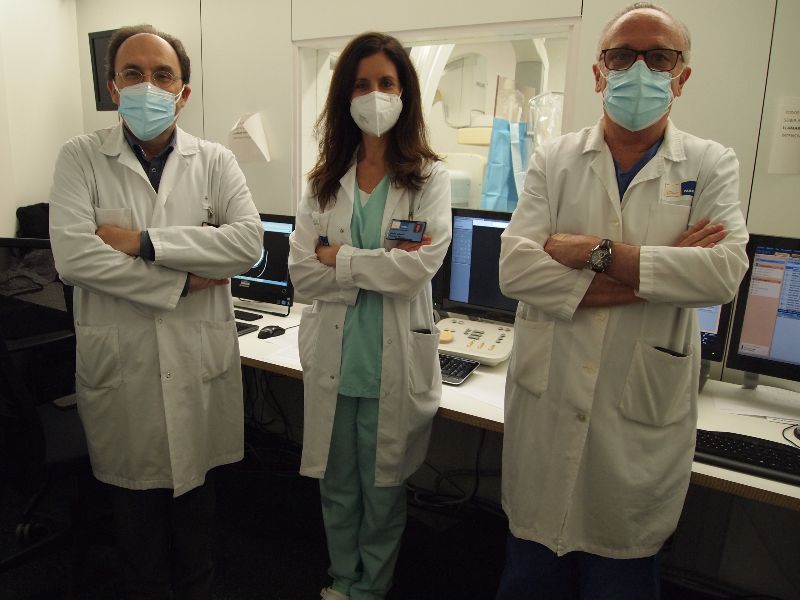
18/12/2020 - Press release
The most exhaustive study ever carried out on the short- and long-term prognosis for this pathology
The journal Neurology has just published the most complete and exhaustive study to date on the survival rate and sequelae of patients who suffer a ruptured brain aneurysm, a disease known as subarachnoid haemorrhage. The work was carried out by doctors at Hospital del Mar (from the Neurology, Neurosurgery, Intensive Medicine, Interventional Neuroradiology, Radiology and Anaesthesia and Resuscitation services) and researchers from the Hospital del Mar Medical Research Institute (IMIM). The results show that the strategy implemented in Catalonia to cover emergency care for this condition produces results comparable to those of the most advanced centres in the world.
The data analysed corresponds to 311 patients with aneurysmal subarachnoid haemorrhage treated at Hospital del Mar over the last 12 years. The short-term mortality rate is between 8.7% (one week after treatment, during the hospitalisation period), and 18.4% (after three months). One year after the vascular event, this figure reaches 22.9% and, five years later, 29%. Only 7% of the patients who survived after five years presented disabling sequelae. According to several studies, deaths from this pathology around the world are between 11% and 27.5% in hospital and over 30% after three months.

From left to right: Dr. Jaume Roquer, Dr. Gloria Villalba and Dr. Leopoldo Guimaraens. Source: Hospital del Mar.
Two types of approach
Treating subarachnoid haemorrhage is complex and requires the participation of a multidisciplinary and highly trained team. As Dr. Jaume Roquer, head of the Neurology Service and Neurovascular Research Group at the IMIM and lead author of the study, explains, "Teamwork between professionals who are highly trained in their field and specialists in the treatment of this pathology allows us to obtain very good results." The study also analysed the results obtained according to the different approaches taken.
One of the critical aspects for successfully treating a brain aneurysm is its rapid diagnosis and treatment. This is why, when a patient arrives at the hospital, specialists in Interventional Neuroradiology locate the point where the lesion has occurred and repair it, on the spot, if possible. Other patients are treated by the Neurosurgery teams.
This difference improves the results of the endovascular treatment, since endovascular access allows the ruptured aneurysm to be repaired quickly. Consequently, 43.8% of these patients require mechanical ventilation, compared to 65.2% who require neurosurgical treatment. In addition, their stay in the hospital is two days shorter and the sequelae are milder.
Along these lines, Dr. Gerard Conesa, head of the Neurosurgery Service at Hospital del Mar, and Dr. Gloria Villalba, a consultant in the same service, emphasise that "Patients destined for surgical treatment at our centre are complex cases, either because of the shape of the aneurysm or because it is accompanied by a haematoma that is causing a very serious neurological state, and the haematoma and aneurysm have to be operated on at the same time. It is therefore understandable that the results of endovascular treatment in the hospital are better." Dr. Leopoldo Guimaraens, head of the centre's Therapeutic Neuroangiography Service, confirms that "In the patients we treat, the endovascular approach to intracranial aneurysms has a better prognosis than the surgical approach. The most important aspect is that our centre has very high quality services for treating this difficult pathology."
The hospital on-call system
Subarachnoid haemorrhage is a relatively rare but very serious and highly complex pathology, which mainly affects people with an average age of 53. A patient's progress is dependent on them receiving urgent care during the first few hours, and on carrying out an exhaustive medical follow-up over the first few days, to prevent, identify and treat the serious complications that these patients often present. Only certain hospitals are adequately prepared to treat these people. In Catalonia, there is an on-call system, whereby there is always one specialist treatment centre ready to receive cases. This comprises 5 hospitals, one of which is Hospital del Mar. Dr. Roquer affirms that "The Catalan system guarantees that all patients have access to emergency treatment. The data from our study show that the model is successful and that it really works."
Reference article
Short- and long-term outcome of patients with aneurysmal subarachnoid hemorrhage. Jaume Roquer, Elisa Cuadrado-Godia, Leopoldo Guimaraens, Gerardo Conesa, Ana Rodríguez-Campello, Jaume Capellades, María P. García-Arnillas, Juan L. Fernández-Candil, Carla Avellaneda-Gómez, Eva Giralt-Steinhauer, Jordi Jiménez-Conde, Carolina Soriano-Tárraga, Gloria Villalba-Martínez, Rosa M. Vivanco-Hidalgo, Elio Vivas, Angel Ois Neurology Sep 2020, 95 (13) e1819-e1829; DOI: 10.1212/WNL.0000000000010618
Servei de Comunicació:
Marta Calsina Freixas(ELIMINAR)
Tel:
(+34) 93 316 06 80
Doctor Aiguader, 88
08226 Barcelona
© Institut Hospital del Mar
d'Investigacions MèdiquesLegal Notice and Privacy Policy | Cookie Policy | Site Index | Accessibility | Find Us | Contact